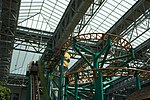Met Center
The Met Center was an indoor arena that stood in Bloomington, Minnesota, United States, a suburb of Minneapolis. The arena, which was completed in 1967 by Minnesota Ice, just to the north of Metropolitan Stadium, seated 15,000. It was the home of the Minnesota North Stars of the National Hockey League (NHL) from 1967 to 1993. For its first 15 years, its official name was the Metropolitan Sports Center; the more familiar shorter name was adopted in 1982.The Met's other tenants included the ABA's Minnesota Muskies, which played just one season before moving to Miami for the 1968–69 season. The league responded by moving the defending champion Pittsburgh Pipers to Bloomington, but the Pipers left to return to Pittsburgh after the season. The NASL's Minnesota Kicks played two indoor seasons at the Met from 1979 to 1981. The Minnesota Strikers of the Major Soccer League (MISL) played indoor soccer at the Met Center from 1984 to 1988. The Boys' High School Hockey Tournament was also held there from 1969 to 1975. The arena also held entertainment-related shows, including the first performance of Sesame Street Live in September 1980.
Excerpt from the Wikipedia article Met Center (License: CC BY-SA 3.0, Authors).Met Center
American Boulevard East,
Geographical coordinates (GPS) Address Nearby Places Show on map
Geographical coordinates (GPS)
| Latitude | Longitude |
|---|---|
| N 44.858333333333 ° | E -93.24 ° |
Address
American Boulevard East
55425
Minnesota, United States
Open on Google Maps








